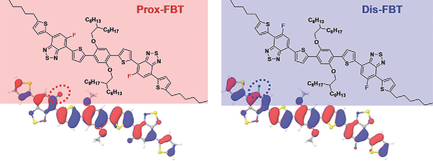Two Regioisomeric π-Conjugated Small Molecules:
Synthesis, Photophysical, Packing and Optoelectronic Properties


Dae Hee Lee(박사과정) / Thanh Luan Nguyen(Post doc.)
Two regioisomeric D1-A-D-A-D1 type π-conjugated molecules (1,4-bis{5-[4-(5-fluoro-7-(5-hexylthiophen-2-yl)benzo[c][1,2,5]thiadiazole)]thiophen-2-yl}-2,5-bis(hexyldecyloxy)benzene (Prox-FBT) and 1,4-bis{5-[4-(6-fluoro-7-(5-hexylthiophen-2-yl)benzo[c][1,2,5]thiadiazole)]thiophen-2-yl}-2,5-bis(hexyldecyloxy)benzene (Dis-FBT)) are synthesized, by controlling the fluorine topology to be proximal or distal relative to the central core. The different F geometries are confirmed by the 1H–1H nuclear Overhauer effect spectroscopy (NOESY). Clearly different optical, electrochemical, and thermal transition behaviors are obtained, i.e., stronger absorption, deeper valance band (by ≈0.2 eV), and higher melting/recrystallization temperatures (by 7–20 °C) are observed for Dis-FBT. The different intermolecular packing and unit cell structures are also calculated for the two regioisomers, based on the powder X-ray diffraction and 2D grazing-incidence wide-angle X-ray diffraction measurements. A tighter π–π packing with a preferential monoclinic face-on orientation is extracted for Dis-FBT, compared to Prox-FBT with bimodal orientations. Different topological structures significantly affect the electrical and photovoltaic properties, where Prox-FBT shows higher parallel hole mobility (2.3 × 10−3 cm2 V−1 s−1), but Dis-FBT demonstrates higher power conversion efficiency (5.47%) with a larger open-circuit voltage of 0.95 V (vs 0.79 V for Prox-FBT). The findings suggest that small changes in the topological geometry can affect the electronic structure as well as self-assembly behaviors, which can possibly be utilized for fine-adjusting the electrical properties and further optimization of optoelectronic devices.

http://onlinelibrary.wiley.com/doi/10.1002/adfm.201701942/full
최동훈교수 홈페이지 : http://fpl.korea.ac.kr/
우한영교수 홈페이지 : http://www.ooml.korea.ac.kr/



















